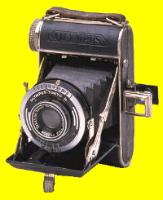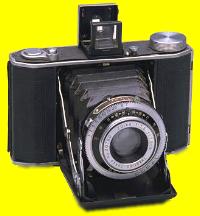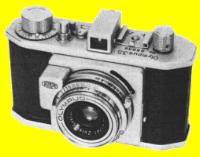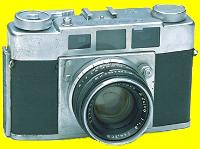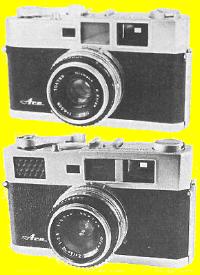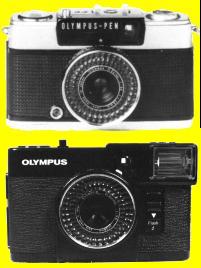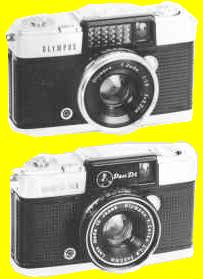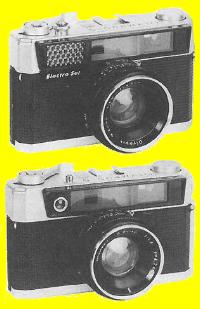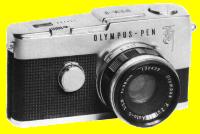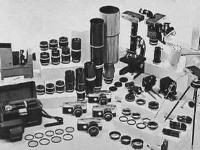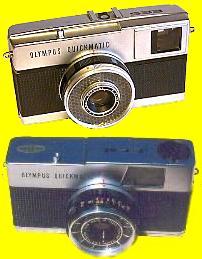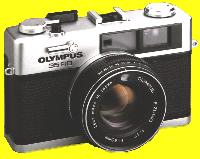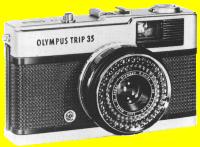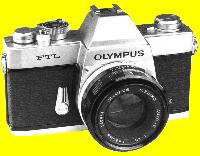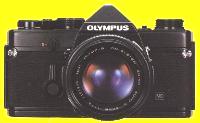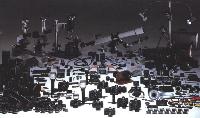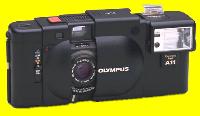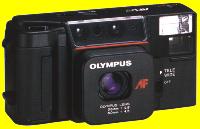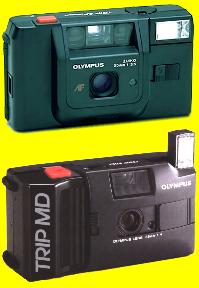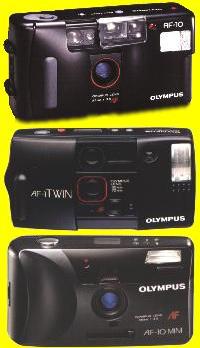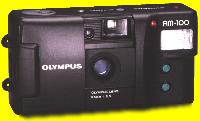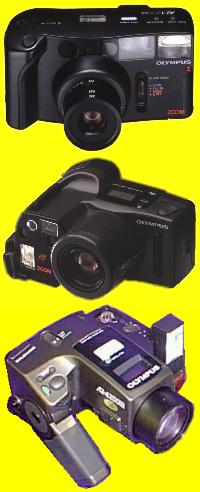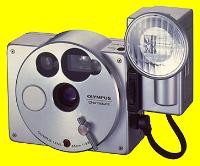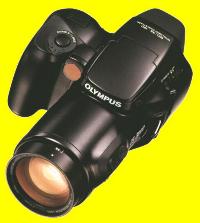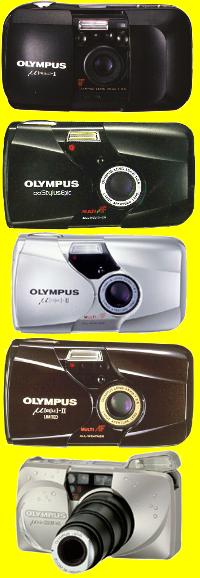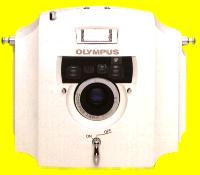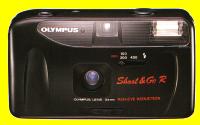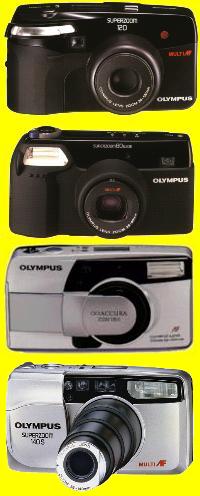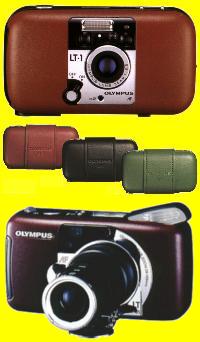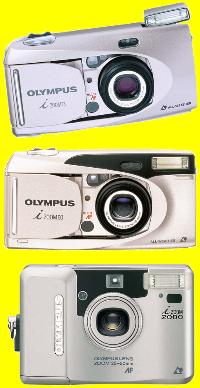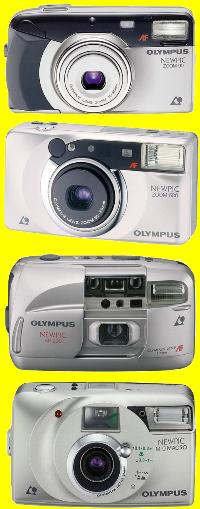| 1936 1938 |
Semi-Olympus Model I Semi-Olympus Model II |
|
The very first camera that carried the name Olympus was the 120 roll
film bellows camera Semi-Olympus I. Only the lens, a fixed Zuiko 75mm F4.5 was made by
Olympus; the body was made by The Proud Company, and the shutter was a German Auto Compur.
Perhaps this explains the name. Its successor, the Semi-Olympus II however was a full Olympus product with a Koho shutter. This body was horizontally orientated and had a rigid finder instead of a folding one. |
| 1937 | Standard |
|
The Olympus Standard was a 127 roll film (645 format) rangefinder system camera was only prototyped and never put into production because of the war. Only 10 examples were made. It used interchangeable lenses, with a Zuiko 65mm F3.5 standard lens. |
| 1939 1948 1948 1950 1954 1954 1955 1955 |
Six Chrome Six I Chrome Six II Chrome Six III Chrome Six IVa Chrome Six IVb Chrome Six V Chrome Six RII |
|
The Olympus Six was a further development of the Semi-Olympus. The
name is based on the 120 roll film format for 6x6 exposures. It incorporated a fixed Zuiko
75mm F3.5 lens and a Koho shutter. Production of this camera was stopped between 1942 and 1945 because of the war. The post war Olympus Chrome Six used a die cast body for higher precision and strength. In the Model II a Zuiko 75mm F2.8 was used. Model III introduced a Film Plane Stabilizer which improved sharpness. The Chrome Six IVa had a 75mm/F3.5 lens and an uncoupled rangefinder. |
| 1948 1949 1949 1949 1953 1954 1955 1955 |
35 I 35 II 35 III 35 IV 35 IVa 35 IVb 35 Va 35 Vb |
|
The "35" Series can be grouped into three sub series: - the I/II/III/IV/V series from 1948-1955 - the S I/S II/K series from 1955-1959 - the LE/LC/SP/RC/EC/ECR/RD/ED series from 1966-1978. The Olympus 35, Model I was not only the first 35mm film model Olympus made, it was also the very first lens shutter type 35mm camera ever to be made in Japan. It incorporated a fixed Zuiko 40mm/F3.5 lens. The film mask had an unconventional size: 24x32mm instead of the usual 24x36mm. All models in this series were viewfinder cameras; none of them had a built-in meter. |
| 1952 1953 1954 1955 1956 |
Flex B I Flex B II Flex A3.5 Flex A2.8 Flex A3.5 II |
|
This series of Twin Lens Reflex cameras for 6x6 roll film was released at
a moment this camera type reached the top of its popularity. Literally hundreds of models
from numerous manufacturers were available - 300 made in Japan in the fifties only. The
Rolleiflex set the standard for this camera type. The Olympus Flex B cameras had two fast 75mm/F2.8 lenses. The Flex A cameras were simplified models. These cameras were the last series of 120 (6x6 cm) film camera models Olympus made. |
| 1955 1957 1957 1958 |
Wide Wide E Wide S Wide II |
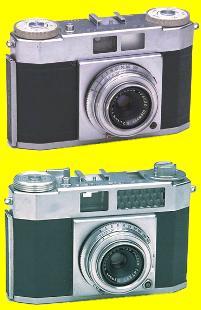 |
The Wide models had 35mm wide-angle lenses. The Wide S was a rangefinder,
the other models were viewfinder cameras. The E and S models had a built-in meter. No AE. |
| 1955 1957 1957 1957 1957 |
35-S I 3.5 35-S II 2.8 35-S II 2.0 35-S II 1.8 35-K |
|
Rangefinders featuring a 42mm lens with speeds of F3.5, 2.8, 2.0 and 1.8. Shown is the S II 1.8. No built-in meter or AE. |
| 1958 1958 |
Eyeflex A Eyeflex B |
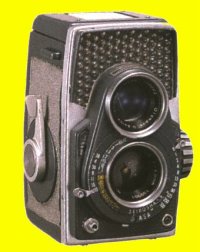 |
The Eyeflex cameras were inspired by the Baby Rolleiflex
Twin Lens Reflex camera for 127 (4x4 cm) film, introducing Automatic
Exposure (AE) with shutter priority, simultaneously with the Auto / Auto
Eye cameras for 35mm film (see below). They had a huge selenium cell, and an option to switch from AE to manual exposure. The A model had two 60cm/F3.5 D.Zuiko lenses, the B model had two 60cm/F2.8 D.Zuiko lenses. Only the A model was introduced to the public, the B model was never put into production. Decline in 4x4 popularity TLRs meant that R&D was stopped. |
| 1958 1959 1960 1962 |
Auto Auto B Auto Eye Auto Eye II |
|
These rangefinders were the first that featured AE (shutter speed
priority). The Auto had a 42mm/F1.8 lens, the Auto Eye models had a 45mm/F2.8 lens. All of
them had a built-in Selenium meter. Other features: parallax compensation, Copal SV shutter with speeds B, 1~1/500, M & X flash synchro. |
| 1959 1960 1964 1965 |
PEN PEN S 2.8 PEN W PEN S 3.5 |
|
The introduction of the Olympus PEN marked the beginning of the success
story of Olympus as manufacturer of small innovative cameras. It runs parallel with the
success story of its designer: Yoshihisa Maitani. His first assignment for Olympus was to design a small, affordable quality camera. The result, the first PEN, was originally not produced by Olympus but when it turned out to be a very popular camera Olympus took production in its own hand, changed the model to PEN S, and many models were to follow. They all had one thing in common: a very pocketable size, using the half-frame (18x24mm) 35mm film format. This allows twice the number of shots on one roll, up to 72! The original PEN had a fixed Zuiko 28mm/F3.5. For half-frame this is a semi-wide lens (the equivalent of a 35mm lens on full frame). The PEN S, which was the first PEN made by Olympus, used a Zuiko 30mm/F2.8. The PEN W used a semi wide angle Zuiko 25mm/F2.8. None of these models had a built-in meter. |
| 1958 1958 |
Ace Ace-E |
|
The Ace bodies were full frame 35mm rangefinder cameras with exchangeable
lenses. Four lenses were available: 35mm/F2.8, 45mm/F2.8, 80mm/F4 and 80mm/F5.6. They featured parallax compensation, Copal SV shutter with speeds B, 1~1/500, M & X flash synchro. The Ace didn't have a built-in meter, the Ace-E did. Accessories were limited to lens shade, filters and everready case. The Ace E was also sold for Sears & Roebuck using the name "Tower 19". |
| 1961 1962 1965 1965 1965 1966 1966 1967 1968 1968 1973 1981 |
PEN EE PEN EE-S PEN EM PEN Rapid EE-D PEN Rapid EE-S PEN EE-EL PEN EES-EL PEN EE-D PEN EE-S2 PEN EE-2 PEN EE-3 PEN EF |
|
The PEN EE ("Electric Eye") Series featured a built-in meter
and automatic exposure (AE). The first model, the EE, used a simplified AE: there was only
one shutter speed (1/60) and the aperture was selected by the camera. On the later models two shutter speeds were available: 1/200 for AE and 1/40 intended for flash exposure with manual selectable apertures (also allowing manual exposure). The first models used a selenium meter round the lens, later models used a CDS cell in the camera. Lens design was also changed on the various models. The original EE used a 28mm/F3.5, the EE-S had an 30mm/F2.8, the EM had a 35mm/F2 and the EE-D featured a fast 32mm/F1.7 lens next to Program Exposure (!). The EM was a motorized model, the EF had a built-in flash. The Rapid EE-D and EE-S were outsider models: they took the AGFA half-frame Rapid film cassettes instead of standard 35mm film. |
| 1962 1964 1965 |
PEN D PEN D-2 PEN D-3 |
|
The PEN D Series featured a built-in meter (selenium on the PEN D, CDS on
the D-2 and D-3) but no AE. Instead they offered a full range of manually selectable
shutter speeds (B, 1/8~1/500) and a fast 32mm/F1.9 lens (F1.7 on the D-3). The number of accessories for the PEN, PEN E and PEN D Series was limited to everready cases, lens hoods, filters, close-up lenses, a copy stand, a flash for AG1 bulbs, half frame slide frames and a half frame viewer. |
| 1962 1963 |
S Electro Set S (CdS) |
|
Rangefinder models with built-in meter (Selenium in the "Electro
Set", CdS in the second model). Zuiko 42mm/F1.8 lens. |
| 1963 1966 1966 1966 1968 1969 |
PEN F PEN FT PEN FT Black PEN FV PEN F Microscope PEN FT Microscope |
|
The culmination of the PEN Series was the half-frame SLR PEN F System. This was a full-blown professional SLR camera system that was almost as versatile as the OM System that was launched nine years later in 1972. The PEN F camera bodies were masterpieces of camera design by Maitani featuring an ingenious porro prism instead of a pentaprism, which allowed the bodies to be built as flat as the viewfinder PEN models, and a rotary shutter that allowed electronic flash synchronization at all shutter speeds. The Pen F and FV bodies didn't have a built-in meter. Instead an accessory meter could be clamped onto the shutter speed dial at the front. The FT body did have a built-in CDS meter. New versions of the System lenses were released for this model. There were also two special microscope versions (F based and FT based) with a photomicroscopic focusing screen. There were 17 Zuiko Pen F lenses available: 20mm/F3.5, 25mm/F2.8, 25mm/F4.0, 38mm/F3.5 Macro, 38mm/F2.8, 38mm/F1.8, 40mm/F1.4, 42mm/F1.2, 50-90mm/F3.5 Zoom, 60mm/F1.5, 70mm/F2.0, 100mm/F3.5, 100-200mm/F5.0 Zoom, 150mm/F4.0, 250mm/F5.0, 400mm/F6.3, 800mm/F8 Reflex. Besides a few independent manufacturers made lenses in the Pen F bayonet mount. Accessories for the System included: Bellows (two versions), Slide Duplicator, Focusing Rails, Extension Tubes, Microscope Adapter, Angle Finder, Magnifying Angle Finder, Viewfinder Magnifier, Eyepiece Correction Lenses, Close-up Lenses, Copy Stand, Reverse Ring, Lens Adapters for Praktica, Exakta, Nikon or Leica lenses, Filters (43mm and 49mm) and a Combi Case. The Pen F System was discontinued in 1970. |
| 1966 1966 1967 1967 |
Quickmatic EES 3.5 Quickmatic EES 2.8 Quickmatic EEM Quickmatic 600 |
|
Cameras made for Kodak "Instamatic" 126 film (28x28mm). Automatic Exposure with two shutter speeds (1/40 and 1/200 sec) and automatic film speed detection. Three focusing zones. The EES 3.5 had a Zuiko 36mm/F3.5, the EES 2.8, EEM and 600 had a Zuiko 36mm/F2.8; the EEM had a built-in motor. |
| 1966 1967 1969 1970 1971 1971 1971 1972 1972 1973 1974 1974 1975 |
35 LE 35 LC 35 SP 35 RC 35 DC 35 EC 35 EC2 35 ECR 35 SPN 35 UC 35 DC (with battery checker) 35 ED 35 RD |
|
The last of the "35" Series were compact full frame 35mm
cameras, some with a viewfinder but most with a rangefinder. They all had a fixed lens.
Exposure modes varied from Shutter Speed Preferred Automatic Exposure + Manual Mode to
Full Auto. Lenses: 42mm/F1.7 (LE,LC,SP), 42mm/F2.8 (RC,EC,ECR), 40mm/F1.7 (RD), 38mm/F2.8 (ED). The models starting with the SP featured the flashmatic system - the GN of the flash is set on the camera, the camera selects the aperture based on this GN and the selected distance. The SP featured spot metering. |
| 1967 | Trip 35 |
|
The Trip 35 can be seen as the full frame 35mm version of the PEN,
featuring a Zuiko 40mm/F2.8 lens, AE with two shutter speeds (1/40 and 1/200 sec), three
zone focusing (no rangefinder). Identical filter size (43.5mm) as the PEN's. It was one of the longest running camera models - introduced in 1967, discontinued in 1984. It saw the rise and fall of most "35" and OM models... Its "successor", the Trip AF which was released in 1984; the Trip AF Series however are not really related and only borrowed its very popular name. |
| 1970 | FTL |
|
The FTL was the only body of Olympus' first full frame 35mm SLR System. It was released only two years before the (O)M-1, at a stage when the preparation and design of the OM System must have been almost completed. Perhaps Olympus was a bit impatient, or used the FTL for prototyping. Six Zuiko lenses were made for the FTL System, which had a Praktica screw thread. All of them were later introduced in the OM System: 28mm/F3.5, 35mm/F2.8, 50mm/F1.4, 50mm/F1.8, 135mm/F3.5 and 200mm/F4. The rest of the FTL System consisted of: a Bellows, Slide Duplicator, Extension Tubes, Focusing Stage, Microscope Adapter, Eyecup, Right Angle Finder, Viewfinder Magnifier, Reverse Ring, Close-Up Lens, Lens Hood and Everready Case. The FTL System was discontinued in 1972. |
| 1972 1973 1974 1975 1979 1979 1979 1983 1983 1983 1984 1984 1984 1985 1986 1987 1988 1990 1995 1997 |
M-1 OM-1 OM-1 MD OM-2 OM-1N OM-2N OM-10 OM-3 OM-20 OM-30 OM-2SP OM-4 OM-10 QD OM-40 OM-707 AF OM-4Ti Champagne OM-101 PF OM-4Ti Black OM-3Ti OM-2000 |
|
The OM System, which is the main subject of my
site, is Maitani's masterpiece in Camera System design. Enough finger practices with
the PEN F and FTL - the (O)M-1 was a full blown true system camera, that added
exchangeable focusing screens, an exchangeable camera back and hundreds of accessories
ready to compete with the camera systems from Nikon and Canon. The main characteristic of the OM System was the small size of the bodies, lenses and accessories, without giving in on the reliability or versatility of the system. The professional bodies of the competition looked like huge bricks compared to the (O)M-1. And, as a matter of fact, they still do. The (O)M-1 wasn't even that much bigger and heavier than its half-frame sister: PEN F : Size: 127 x 69.5 x 32.5mm. Weight: 560g. with standard lens. (O)M-1: Size: 136 x 83 x 50 mm. Weight: 660g. with standard (F1.8) lens. The addition of Motor Drive capabilities in 1974 and AE in 1975 (OM-2), in combination with the TTL, Off The Film metering of available and flash light, still without adding size or weight to the bodies finished off the base concept of the OM line and definitely put Olympus on the map as trendsetter in innovative camera design. In lens design, Olympus also featured some "firsts" and still do. No other SLR manufacturer has such a wide range of F2 lenses: 21mm - 250mm . |
195? 195? 196? 1968 198? 198? 199? |
Microscope cameras PM-6 PA-35 C-35 PEN F Microscope C-35-DA2 SC35 PM-10SP |
|
Olympus, as manufacturer of microscopes and cameras obviously also made
and still makes Microscope Cameras. The 'Small Photomicrographic Apparatus' PM-6 was a combination of a "35" I/II/II/IV/V Series based camera and a Manual Exposure Body (also labeled PM-6). The magnification of the film plane was about 1/3 of the total magnification of the microscope. It was intended for small microscopes like the G Series. The PA-35 camera was almost identical to the PM-6 camera. There were also other versions of the shutter: PM-7 and probably also earlier versions. The C-35 models were based on the Trip 35 but had no finder, shutter or lens. The C-35A had a built-in winder. They attached to Exposure Bodies with the PM-35 adapter. The PEN F / PEN FT based microscope cameras were almost identical to the normal version. They had a fixed focusing screen for microphotography. The C-35-DA2 and C-35-AD4 bodies are based on OM-3/4 bodies but have no viewfinder, prism, mirror, meter, shutter speed ring or shutter. The exchangeable camera back is identical to the back of the OM-2/3/4. The C-35-AD4 has a built-in winder; it is triggered by the Automatic Exposure Body PM-PBS and requires the adapter PM-35A to pass the electrical signals. The shutterless bodies can be mounted on the photomicroscopic Manual Exposure Bodies PM-6, PM-7 or PM-PBM, or Automatic Exposure Bodies PM-PBA/PM-PBS. A special bayonet is used, and a special bayonet shutter which closes the front of the camera when it is removed from the adapter. Exposure is controlled by the shutter inside the Exposure Bodies, the microscope aperture and lighting equipment. Focusing is done by eyepieces attached to the Exposure Bodies. Another option is a Polaroid Back, connected to a special cone shaped Polaroid Adapter. The SC35 is a modified version of the OM-101 PF, with a fixed focusing screen for microphotography. The PM-10SP isn't based on any existing model and is part of the Photomicrographic Systems PM-10SP, PM-20 and PM-30. The DP11 is a digital camera. |
| 1979 1980 1980 1985 1985 |
XA XA-1 XA-2 XA-3 XA-4 Macro |
|
The XA was another amazing Maitani design. Without its auxiliary
A11 or A16 flash it's not much bigger than a typical modern non-zoom P&S camera,
although maybe a bit heavier (225g.). Yet it features a fast 35mm/F2.8 lens, rangefinder
and aperture-preferred AE, with indication of shutter speed! No 'brain dead program
shooting at F9 or slower' here... The clamp shell cover of the XA models made it possible to carry them in a pocket or purse without further protection. The XA-1, -2, -3 and -4 didn't have a rangefinder or aperture preferred AE, but zone focusing lens and program exposure instead, and a slower (F3.5) lens. Some of them were available in 'poppy' colours. The XA-4 Macro had a 28mm/F3.5 lens that could focus at 30cm. |
| 1981 | C-AF | 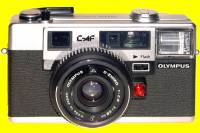 |
The C-AF was the first Olympus camera with Auto Focus
(Infra Red controlled) and also the first with built-in flash. This models clearly marks a turning point in camera technology. With its compact rangefinder looks like the 35 RD / 35 DC etc. series but with AF electronics instead of the rangefinder it belongs to two completely different worlds. This camera seems to have been introduced as some sort of pilot in AF technology and was not available in all countries (maybe only in Japan?). It featured a D.Zuiko 38mm/F2.8 lens and programmed exposure. The film speed it the only thing that is adjustable. |
| 1984 1986 1986 |
AFL Quick Flash AFL-S AFL-T |
|
The AFL models models were the second AF P&S camera series that
Olympus made; these cameras were marketed at a larger scale as the C-AF. The AFL Quick Flash had a 35mm/F2.8 (!) Olympus Lens (the name Zuiko was no longer used), shutter speeds from 1/8 to 1/500 and was very expensive for a P&S camera when it was introduced, almost as much as an OM-10. The AFL-S had a standard lens; an auxiliary teleconverter was available. The AFL-T had a Tele-Wide Twin lens, which were actually two lenses: 36mm/F2.8 (4 el./3 gr.) and 60mm/F4.5 (8 el./7 gr.). |
| 1984 1986 1986 1987 1990 1990 1992 1992 1993 1993 1994 1995 1995 1996 1996 1998 2000 2000 2000 |
Trip AF Trip AF MD Supertrip Trip MD Trip AF Super Trip MD2 Trip AF S-2 Trip Panorama Trip 100 Trip AF Mini Trip AF-1 Mini Trip AF-1 Mini QD Trip AF-20 Trip 300 Trip AF-30 Trip MD3 Trip XB-40 AF Trip XB-41 AF Trip XB 400 |
|
The new generation Trip models borrowed the name from the very successful
Trip 35 (1967), which was discontinued not long after the Trip AF was introduced in 1984.
For the rest there is absolutely no relationship in terms of camera design, technology or
accessories. But using this name was not only marketing technique - it reflected the same
philosophy of cameras to carry anytime anyware without being bothered by an overload in
weight or technique. The Trip AF which was introduced simultaneously as the AFL Quick Flash was a representative of the new generation of electronic compact point and shoot cameras. The Trip AF was much cheaper (about the half) than the AFL, had a 35mm/F3.5 AF Olympus Lens and shutter speeds of 1/85 to 1/120 sec. The Trip AF MD featured a 35mm/F3.8 lens and built-in motor. The Trip MD had a fixed focus 35mm/F4 lens and built-in motor; the Supertrip featured the same lens but no motor, the Trip 100 had a 35mm/F4.5 lens. These were simplified models with only one shutter speed (1/125 sec.). The current Trip XB models feature a 27mm (!)/F6.3 lens, AF, DX decoding, red eye reduction, built-in motor and one shutter speed (1/100 sec.). These cameras weigh only 150g., versus 230g. for the Trip MD or 410g. for the Trip 35. |
| 1986 1987 1987 1987 1989 1989 1989 1989 1990 1991 1991 1991 1995 1995 1995 1998 |
AF-1 AF-1 QD AF-10 AF-10 Data AF-1 Super AF-1 Super Data AF-1 Twin AF-1 Twin QD AF-10 Super AF-10 Super QD AF-10 Twin AF-10 Twin QD AF-1 Mini AF-1 Mini QD AF-10 Mini AF-10 XB |
|
All cameras in the AF series (called Infinity in the US)
had and still have, as the name emphasizes, Auto Focus lenses, which is not true for all
models of the Trip series. In this case AF technology was used as a marketing technique -
most P&S models released since the mid eighties in the middle and upper class price
range feature AF. All AF models have either a lens of single focal length, or a Twin lens (two focal lengths using two lenses) and built-in motor. The AF-1 was more luxurious and expensive than the Trip AF, featuring a 35mm/F2.8 lens (vs. 35/3.5), a closer focusing range (75cm. vs. 1.2m.), DX decoding, built-in motor (introduced in the Trip AF MD), built-lens protection (like the XA introduced in 1979), a wider shutter speed range (1/30~1/750 sec. vs. 1/85~1/250 sec.) and a more elegant design. There was also a teleconverter and close-up lens available. The AF-1 Twin featured two lenses (Twin): 35mm/F3.6 (3 el./3 gr.) and 70mm/F6.3 (5 el./5 gr.). The current AF-10 XB features a 29mm/F4 lens and an extra large and bright viewfinder ('Reverse Galilean Type') which is also present in the Trip XB models. The main differences between the current Trip models and AF models is the fixed shutter speed of the first vs. program controlled shutter speed of the second. |
| 1987 | AM-100 |
|
The AM-100 featured a 35mm/F3.5 lens with zone focusing: fixed
focus in its normal position, and two addtional setting for close-up (0.5~1m.) and
infinity. This was an interesting alternative since AF cameras were expensive at that
time. Other feautures were a programmed electronic shutter (1/45~1/400 sec.), DX decoding, built-in motor and a Quick Charge Auto Flash (recycle in two seconds). |
| 1988 1988 1989 1989 1989 1989 1990 1990 1991 1992 1992 1992 1992 1992 |
AZ-1 Zoom AZ-300 Superzoom AZ-1 Zoom QD AZ-4 Zoom AZ-200 Superzoom AZ-200 Superzoom QD AZ-330 Superzoom AZ-100 Zoom AZ-210 Superzoom AZ-110 Superzoom AZ-110 Superzoom QD AZ-220 Wide zoom AZ-230 Superzoom AZ-230 Superzoom QD |
|
The AZ Zoom cameras (*also* called Infinity in the US)
were predecessors of modern zoom P&S cameras like the Olympus Mju-Zoom and Olympus
Superzoom series. The AZ-300/330 Super Zoom viewfinder cameras and the AZ-4 Zoom SLR camera can be seen as predecessors of the iS/L SLR cameras in terms of design. The all featured built-in AF zoom lens, zoom finder (except the SLR model AZ-4), flash, motor, DX decoding and programmed AE. Most models also had spot metering. The various lenses were: 35-70mm/F3.5-6.7 (AZ-1), 35-70mm/F4-7.7 (AZ-100), 38-76mm/F4.5-6.2 (AZ-210), 38-90mm/F4.5-7.2 (AZ-230), 28-56mm/F3.5-6.5 (AZ-220 Wide Zoom), 38-105mm/F4.5-6 (AZ-300, AZ-330), 35-135mm/F4.2-5.6 (AZ-4). The SLR model AZ-4 had many features of the iS/L Series but was much heavier (1010 g.) and lacked Aperture Preferred AE (only Program and Manual(?)). It had an option for an auxiliary 1.5x Teleconverter, external flash (L30) and data back. Its built-in flash was the pop-up type. This model was made by Ricoh who also marketed it under its own name. |
| 1988 | O Product |
|
The O Product was a 70 year anniversary camera (the company was founded in 1919) and produced in a limited edition of 20.000. The camera combined classical camera looks with a futuristic designer's look. Although clearly intended to be caressed as a collector's item, it is a modern AF camera with AE, built-in motor and detachable flash, 35mm/F3.5 lens. |
| 1990 1992 1993 1992 1993 1993 1994 1994 1996 1996 1997 1997 1999 1999 2002 2002 |
iS-1000 iS-1000 QD iS-2000 iS-2000 QD / DLX iS-3000 iS-3000 QD iS-100 iS-100 QD iS-100S iS-100S QD iS-200 iS-200 QD iS-300 iS-300 QD iS-5000 iS-500 |
|
The iS/L Series (the models are labelled L in Japan and iS in the rest of
the world) are modern SLR cameras with a built-in AF zoom. This concept which was already
visible in some of the the AZ (Super) Zoom models was called ZLR by Olympus: Zoom
Lens Reflex. A more generic term is 'bridge cameras', cameras that are intended to bridge
the gap between light and compact but not very versatile P&S cameras and versatile but
large and heavy SLR cameras. Olympus was the only manufacturer that was (and still is)
really successful with these kind of cameras. The concept was also applied in the APS Centurion models and some of the digital Camedia cameras. There are two distinct lines in the iS/L Series: the advanced models 1000, 2000, 3000 and 5000 which feature everything one would expect in a normal SLR camera, like full control of aperture and shutter speed and various exposure modes, and the simple models 100(S)/200/300/500 which give much less control of exposure. The most advanced model was the iS-3000 (Japan: L-3; US: iS-3). The iS/L Page contains all details about this series. |
| 1991 1991 1993 1993 1993 1993 1993 1996 1996 1996 1997 1997 1997 1998 1998 1998 1998 1998 2000 2000 |
Mju-I Mju-I QD Mju-I Limited Mju-I Panorama Mju-I Panorama QD Mju-Zoom 70 Mju-Zoom 70 QD Mju-II Mju-II QD Mju-Zoom 105 Mju-Zoom 105 QD Mju-Zoom 115 Mju-Zoom 115 QD Mju-Zoom 140 Mju-Zoom 140 QD Mju-II Limited Mju-Zoom Wide 80 Mju-Zoom Wide 80 QD Mju-II Zoom 80 Mju-II Zoom 80 QD |
|
The Mju Series cameras (called Stylus /
Stylus
Epic in the US) are one of Olympus' best selling AF P&S 35mm camera Series
until today. They can be seen as modern AF variants of the popular XA cameras from the 1980's. The cameras are extreme compact and lightweight, have a design look and a clampshell closing mechanism. AF performance was improved compared to the AF series, also the viewfinder was improved. The Mju-I (US: Stylus), now discontinued, had a 35mm/F3.5 lens. Its successor, the Mju-II, still available, has a 35mm/F2.8 lens, a speed which is astonishing for a camera in its price class. The QD version has a date back and is available in Champagne finish. From both cameras limited editions were produced: 50.000 Mju-I Limited (US: Stylus Limited), which was deep metallic black, were made, and 65.000 Mju-II Limited (US: Stylus Epic Limited), which has a dark bronze colour and a panorama mode. The zoom base models are: Zoom 70 (35-70mm/F4.5-6.9), Zoom 105 (38-105mm/F4.5-8.9), Zoom 115 (38-115mm/F4.5-9.7), Zoom 140 (38-140mm/F4-11), Zoom Wide 80 (28-80mm/F4.5-8.4), II Zoom 80 (38-80mm/F4.5-8.4). All these models have QD versions with data back and Champagne Gold finish. |
| 1991 | Ecru |
|
Just like the O Product from 1988, the Ecru was a limited edition design model. It had a 35mm/F3.5 AF lens that could focus to 35cm. |
| 1993 1996 |
Shoot & Go Shoot & Go R |
|
The Shoot & Go cameras are very basic models with a fixed focus 34mm/F6.3 lens, a single speed (1/100) mechanical shutter, mechanical film transport, built-in flash and a manual ASA setting of 100/200 or 400. Model R has a red eye reduction light built in. |
| 1993 1994 1994 1994 1994 1995 1995 1995 1996 1996 1996 1997 1999 1999 1999 1999 1999 1999 1999 1999 2000 2000 2000 |
Superzoom 70 Superzoom 80 Wide Superzoom 80 Wide QD Superzoom 110 Superzoom 110 QD Superzoom 70 QD Superzoom 120 Superzoom 120 QD Superzoom 105 Superzoom 800 Superzoom 800 QD Superzoom 700 BF Superzoom 105R Superzoom 115 Superzoom 140S Superzoom 140S QD Superzoom 700 XB Superzoom 700 XB QD Superzoom 800S Superzoom 800S QD Superzoom 115 QD Superzoom 130S Superzoom 130S QD |
|
The Superzoom series (US: Accura) are all AF P&S
Zoom cameras with built-in flash and automatic film transport. Some of them are almost as
small and light as the Mju Zoom cameras, others, like the Superzoom 120, are larger and
heavier. Their looks are more robust and less elegant design. They are cheaper than the
corresponding Mju Zoom models. Remarkable models were the Superzoom 120 which had a built in 4 fps. Motor Drive, and the Superzoom Wide which had a 28-80mm/F4.5-7.8 lens. Both are now discontinued. The various zoom lensed used are: [70:] 38-70mm/F4.5-7.8, [80:] 28-80mm/F4.5-7.8, [110:] 38-110mm/F3.8-8.1, [120:] 35-120mm/F4.5-8.7, [105:] 38-105mm/F4.5-8.9, [800:] 38-80mm/F4.5-8.9, [700:] 38-70 mm F5.6-9.6, [115:] 38-115mm/F3.9-10.8, [140:] 38-140mm/F4-11, [130:] 38-130mm/F4-10.3. |
| 1995 1996 1997 1997 |
LT-1 LT-1 QD LT Zoom 105 LT Zoom 105 QD Panorama |
|
LT stands for Leather Tech; the cameras have a leather design look. The
case of the LT-1 resembles a wallet rather than a camera case. The LT-1 featured a 35mm/F3.5 AF lens, built-in film transport and flash. It was available in four different colours (brown, burgundy, black & green). The LT Zoom 105 features a 38-105mm/F4.5-8.9 lens. |
| 1998 1999 2000 |
i-Zoom 75 i-Zoom 60 i-Zoom 2000 |
|
The i-Zoom models are APS (IX240 film) cameras with an AF zoom lens,
built-in winder and flash. The supported APS functions are, besides the obvious three selectable film formats (present on all APS cameras), only magnetic date/time (IX) recording. The lenses are: [75:] 28-75mm/F4.7-9.9 (35mm equivalent: 35-94mm), [60:] 28-60 mm/F4.7-8.1 (35mm equivalent: 35-75mm) and [2000:] 25-50 mm/F4.6-8.7 (35mm equivalent: 31-62mm). |
| 1998 1998 1998 1998 1999 1999 1999 |
Newpic 100 Newpic 200 Newpic Zoom 600 Newpic Zoom 90 Newpic M10 Macro Newpic XB AF NewpicXB FF |
|
The Newpic cameras are also APS models. Except the XB FF, all of them
support IX date/time recording and Mid Roll Change (MRC). The 200 and 600 also support
Print Quality Improvement (PQI). The XB FF is a model with a Fixed Focus lens and optical date/time recording. The M10 Macro has a three-zone manual focus lens: normal (1m-infinity, 30cm-1m and 10cm-30cm). The lenses are: [100:] (?), [200:] 27mm/F6.7 (35mm equivalent: 34mm), [Zoom 600:] 30-60mm/F4.5-8.5 (35mm equivalent: 38-75mm), [Zoom 90:] 30-90mm/F4.8-10.5 (35mm equivalent: 38-115mm), [M10:] 24mm/F6.7 (35mm equivalent: 31mm), [XB AF:] 24mm/F4.5 and [XB FF:] 24mm/F6.3. |
| 1998 1998 |
Centurion Centurion S |
|
The Centurion and Centurion-S are the APS variants of the simple iS
models (100/200/300). So they are SLR cameras with a built-on zoom lens, also known as ZLR
(Zoom Lens Reflex) or Bridge Cameras. The only diffence between the two Centurion models is the colour (the early model was black, the S is silver) and support for Mid Roll Change (MRC) in the S. Both support IX date/time recording. They have a 25-100 mm/F4.5-5.6 lens (35mm
equivalent: 31-125mm). The focal length can be enlarged with a screw in TeleConverter to
145mm (35mm equivalent: 180mm). This converter is commonly sold together with the camera
as a kit. |
| 1996 1996 1996 1997 1997 1998 1998 1999 1999 1999 1999 1999 2000 2000 2000 2000 2000 2000 2000 2000 2000 2000 2000 2000 2000 2000 2000 2000 2000 2000 2000 2000 |
Camedia C-400 Camedia C-400L Camedia C-800L Camedia C-420L Camedia C-820L Camedia C-1000L Camedia C-1400L Camedia C-1400XL Camedia C-840L Camedia C-900 Camedia C-830L Camedia C-2500L Camedia C-700 Ultra Zoom Camedia C-2000 Zoom Camedia C-920 Zoom Camedia C-860L Camedia C-21 Camedia C-960 Zoom Camedia C-990 Zoom Camedia C-2000 Zoom Camedia C-2020 Zoom Camedia C-2040 Zoom Camedia C-3000 Zoom Camedia C-3030 Zoom Camedia C-3040 Zoom Camedia C-2100 Ultra Zoom Camedia C-211 Zoom Camedia D-360L Camedia D-460 Zoom Camedia D-490 Zoom Camedia E-10 Camedia E-100RS |
 |
The 'history' of digital cameras including Olympus' Camedia line is one
of rapid movement in technology. In the early 1980's there already existed a still video
camera, and consumer digital cameras already existed in the early 1990's, but their
quality only allowed them to be used for Web publishing and miniature low-resolution
prints. This dramatically changed in the second half of the 1990's - prices dropped, technology improved, the consumer mass gained interest and Olympus jumped in. Their first models from 1996 were P&S style cameras; the highest resolution (C-800) was 810.000 pixels (1024x768), allowing near-photo quality printing on postcard format (10x15cm, A5). Things became more interesting in 1998 with the introduction of the C-1400, a Zoom Lens reflex (ZLR) model (SLR with built-on zoom lens). It had 1.400.000 pixels (1280x1024), aka 1 Megapixel. The next milestone was the 2 Megapixel model C-2500L from 1999 (2.500.000 pixels,1712x1368). This resolution allows photo quality on A5. This camera has a 9.2-28mm/F2.8-3.9 lens (35mm equivalent: 36-110mm). The 3 Megapixel frontier was reached in 2000. The C-3000 Zoom has 3.34 Megapixel (2048x1536 pixels). This resolution allows photo quality printing on 13x18cm, and near photo quality printing on A4. A remarkable product is the 2.11 Megapixel model C-211. It has a built-in Polaroid Printer. The two high-end models introduced at the Photokina 2000, the 4-MegaPixel E-10 and the 1.5-MegaPixel, 15fps E-100RS definitely put back Olympus at the map of professional camera manufacturers. |
